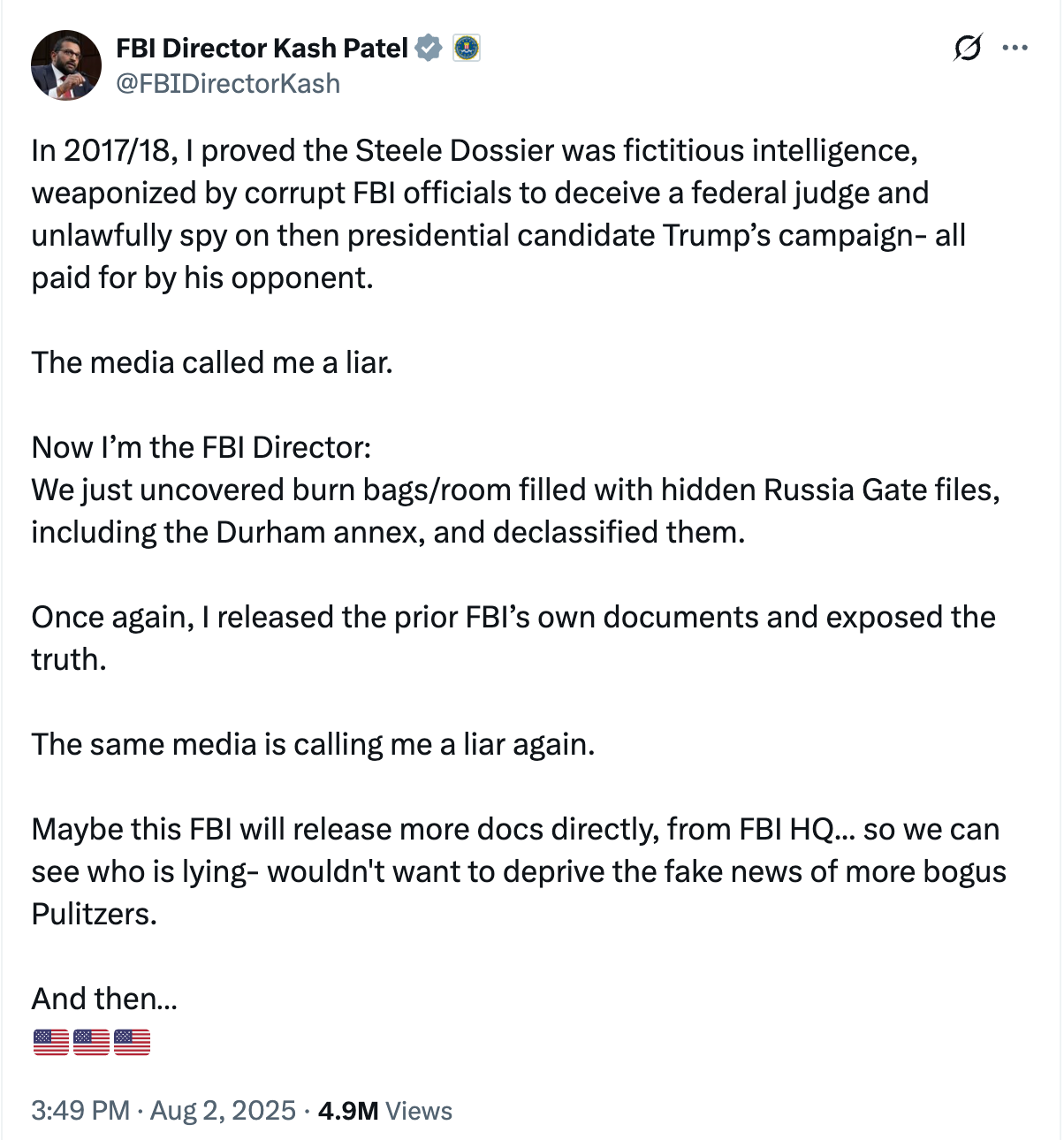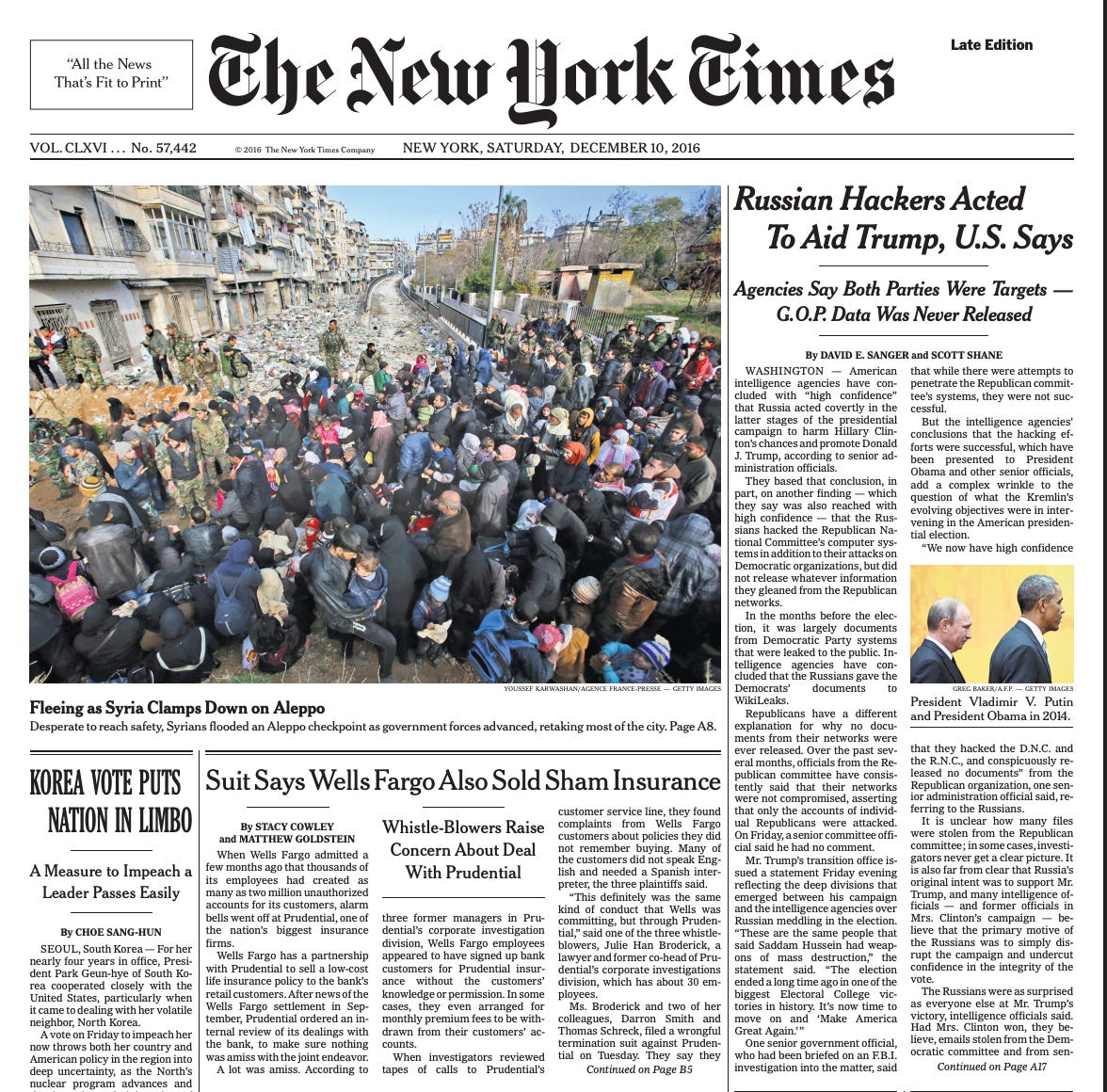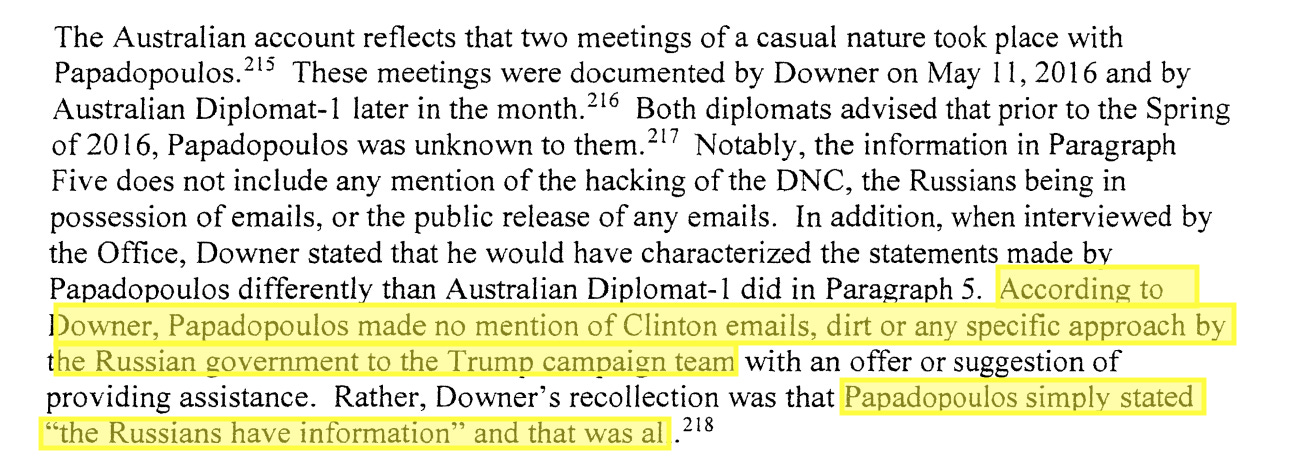Open Letter to the Columbia Journalism Review, on the Atrocious New York Times
The ostensible high priests of journalism should be able to detect the difference between passable coverage and epic, historic failure
Letter to Bill Grueskin, former Dean of the Columbia Journalism School, on his recent article in the Columbia Journalism Review
Mr. Grueskin,
Regarding your August 1 article, “Knowing: Still Only Half the Battle,” which lauds Charlie Savage of the New York Times for having “dissected and eviscerated” Director of Intelligence Tulsi Gabbard’s claims about corruption of intelligence in the Trump-Russia investigation:
You praised Savage’s article, “New Reports on Russian Interference Don’t Show What Trump Says They Do,” as an example of the work of an “experienced beat reporter” who can distill complex stories into a “coherent, compelling whole.” Your sub-headline stressed the importance of “showing receipts” in journalism, where “most people don’t follow stories very closely,” but “they can learn a lot when an experienced beat reporter helps them sort out what’s important and what’s chaff.”
Chaff.
Except — and you should know this because the Columbia Journalism Review published over 20,000 words on the subject in January 2023 — Savage and his colleagues at the Times have badly miscovered this story for nearly a decade, and continue to do so. The 2018 Pulitzer Prize the paper won on the topic along with the Washington Post will go down as the same kind of “disgrace” as its 1932 Pulitzer for Walter Duranty’s breathless coverage of Stalin’s Russia. In this case, the Times drifted so far from its traditional mission that it became an animating motive for Gabbard and other investigators in Donald Trump’s administration.
Witness FBI Director Kash Patel throwing down a gauntlet this weekend, right after your piece ran. He challenged media figures who called him a “liar” in 2018, when as an investigator in the House Permanent Select Committee on Intelligence (HPSCI) chaired by California’s Devin Nunes, he outed the Steele Dossier as “fictitious intelligence” used to deceive a federal judge and unlawfully spy on Trump’s campaign. Patel added, “Now I’m the FBI Director,” then hinted that he might release “more docs” so “we can see who is lying,” before ending with a reference to “bogus Pulitzers.”
Is this normal FBI Director behavior? Would Louis Freeh or William Webster call out a newspaper in such a personal way? Probably not. Would most Times readers even know what Patel is talking about? Also probably not, because the paper has consistently responded to criticism by doing what you did in “Knowing: Still Only Half the Battle”: casually dismiss allegations as “false conspiracies” and “chaff,” things educated people may safely ignore, in favor of the wheat in papers like the Times.
That attitude only works if the facts are on your side. On this story, they aren’t, and it’s not close. About those “receipts” you praised:
As you note, Savage decried “overheated and attention-grabbing claims” made by Trump’s “top officials,” who “accused Mr. Obama of treason and “made criminal referrals” about national security officials under Mr. Obama. Savage may rightly call claims of “treason” overheated, since nothing released yet comes close to meeting the legal definition (though the Times and some of those same “national security officials” similarly overreached when they invoked the word at the beginning of Trump’s first term). There are reports today of the case going to a grand jury, but it’s true we don’t know yet how compelling any criminal evidence might be. Still, Savage added an unsupported line:
The administration is trying to distract supporters who are angry about its broken promise to release the Jeffrey Epstein files.
It’s a small detail, but characteristic of what the Times has become. An experienced beat reporter would know the administration has been investigating Russiagate since Trump’s inauguration, that Patel referenced a discovery in this investigation on the Joe Rogan Experience on June 6th, and that CIA Director John Ratcliffe kicked off the recent releases with a report on the Trump-Russia probe that came out on July 2, before the much-criticized Epstein announcement by Pam Bondi’s Justice Department on July 7th.
There is no fact anywhere to support the idea that recent Russiagate releases are an attempt to “distract supporters who are angry about its broken promise to release the Jeffrey Epstein files.” It’s merely something that sounds right to Times readers, probably because it’s been a talking point hammered by Democratic Party politicians like Arizona’s Mark Kelly (“I think they do not want to talk about Jeffrey Epstein”), Connecticut’s Jim Himes (“A transparent effort to distract from… refusal to release the Jeffrey Epstein files”), even a spokesperson for former President Barack Obama, Patrick Rodenbush (“These bizarre allegations are ridiculous and a weak attempt at distraction”). Since when is it good practice for a paper like the Times to present partisan talking points as facts?
Savage went on to bristle at Tulsi Gabbard’s recent release of a report prepared by Patel’s team in 2017-2018, about the construction of a January 6, 2017 Intelligence Community Assessment (ICA) concluding Russia and Vladimir Putin “aspired” to help Donald Trump, for whom he developed a “clear preference.” The HPSCI report dovetailed with Ratcliffe’s report in showing dissent within the team that put together this critical Assessment.
While Ratcliffe showed that then-CIA Director John Brennan overrode the written objections of his own Deputy Director of Analysis and the judgments of two of his top Russia experts in using a piece of paid opposition research originating from the Clinton campaign, the Steele dossier, the HPSCI report showed “CIA officer judgments” objecting to the three other key pieces of evidence as containing “substandard information.” The HPSCI report also described how two senior CIA analysts confronted Brennan about the flaws of the Steele dossier, and he replied, “Yes, but doesn’t it ring true?”
Your experienced beat writer deigned to describe these and other damning details as “messy,” then dismissed them. One of the key pieces of “evidence” was a “scant, unclear, and unverifiable fragment of a sentence” Brennan himself was told by a supposedly well-placed Russian source eventually “exfiltrated” to Virginia. The fragmentary line, “whose victory Putin was counting on,” turned out to be the only evidence bolstering the notion that Putin specifically wanted to help Donald Trump.
Brennan’s own team objected to the fragment’s use because “five people read it five ways,” because the top source was passing on information of unknown origin, and because Brennan’s methods of conveying the intelligence were suspect. The report was not “formally disseminated” or put in writing; Brennan briefed the group and President Obama orally. The HPSCI investigators summarized complaints of the ICA’s authors:
By briefing the information orally, however, DCIA could have tailored his message to different officials, unconstrained by a consistent record copу.
Savage conveyed many of the details just related: that the intelligence faced objections from report authors, that the report failed to notice this key piece of evidence was “disputed,” that analysts didn’t know what the line meant or “who specifically the mole had heard that from,” and that Ratcliffe concluded the report incorrectly described the key judgment that Putin “aspired” to help Trump warranted “high confidence,” a designation that requires multiple sources, when “only one source explicitly and directly backed that finding.”
So yes, Savage agreed, the sole piece of evidence on which the judgment that Putin “aspired” to help Trump was thirdhand, rejected intelligence of disputed meaning that was also incorrectly labeled as warranting “high confidence.” There is a but passage coming, but it’s worth pausing to note what Savage conceded about the evidentiary basis for countless New York Times stories, including an A1 bombshell put together online on December 9th, 2016, hours after Barack Obama ordered the writing of the new Assessment. In the next day’s print edition, it was headlined: “Russian Hackers Acted to Aid Trump, U.S. Says.”
The lede from that piece:
WASHINGTON — American intelligence agencies have concluded with “high confidence” that Russia acted covertly in the latter stages of the presidential campaign to harm Hillary Clinton’s chances and promote Donald J. Trump, according to senior administration officials.
The Times trumpeted “high confidence” for years, only calling attention to the dissent by the NSA and other CIA analysts when Brennan himself wrote about it in his book, Undaunted, in October of 2020. (The CIA Director had time to write a book before the Times zeroed in on this key detail!) That years-too-late story was called, “Brennan Rebuffed Requests to Lower Confidence in Key Russia Finding.”
As for the use of the Steele dossier in the ICA, the salient fact for any editor attempting objectivity would be that this crude intelligence forgery — later demolished as “rumor,” “speculation,” and “hearsay” in a report by Obama-appointed Justice Department Inspector General Michael Horowitz, who noted the FBI found “zero” corroboration for its claims — was employed at all in such an impactful report. Not according to Savage, who appeared laser-focused on setting up a legal defense against perjury charges for Brennan, writing about how the newly disclosed material “complicates” Brennan’s Congressional testimony:
Mr. Brennan has publicly said the Steele dossier material was not incorporated or used in the assessment itself because of the C.I.A.’s concerns. In 2017, he told Congress that the dossier “was not in any way used as a basis for the intelligence community assessment that was done.”
The newly disclosed material complicates that narrative. For one, it showed that Mr. Brennan internally defended appending a summary of the dossier to the assessment after C.I.A. analysts resisted the compromise, too… For another, the material has revealed that the classified version of the assessment alerted readers to the existence of the annex. It did so in a fourth bullet point under the judgment that Mr. Putin aspired to help Mr. Trump’s chances of winning.
“For additional reporting on Russian plans and intentions, please see Annex A: Additional Reporting from an F.B.I. Source on Russian Influence Efforts,” the bullet point said… Mr. Trump’s allies have argued that this sentence means the information from the Steele dossier was incorporated into the assessment itself.
The great New York Times is reduced to arguing an absurd semantic point, that material included in an “annex” to a report can properly be described as having not been used “in any way” as a “basis” for that same report.
Savage’s other effort in this article is to defend against charges that the CIA used discarded, unclear, unverifiable evidence to secure a “high confidence” judgment by conceding all of the above, but noting that the NSA properly ascribed to the claim “moderate confidence,” which in the intelligence world means something between “not really” and “definitely maybe.”
That is what you described as Savage having “dissected and eviscerated” allegations that Obama and his deputies ginned up “false conspiracies” around the 2016 election.
As a reminder, these “false conspiracies” are the same stories a hyperventilating Times rode all the way to a Pulitzer Prize. How shameful was that Pulitzer? Take one of the winning entries: “Unlikely Source Propelled Russian Meddling Inquiry,” from December 30, 2017. That bombshell report by Sharon LaFraniere, Mark Mazzetti and Matt Apuzzo, about the ostensible origin story of the Trump-Russia investigation, opened in dramatic fashion:
During a night of heavy drinking at an upscale London bar in May 2016, George Papadopoulos, a young foreign policy adviser to the Trump campaign, made a startling revelation to Australia’s top diplomat in Britain: Russia had political dirt on Hillary Clinton.
About three weeks earlier, Mr. Papadopoulos had been told that Moscow had thousands of emails that would embarrass Mrs. Clinton, apparently stolen in an effort to try to damage her campaign.
Obviously, you’re a former Journalism School Dean and I’m not, but I wouldn’t have thought you could win a Pulitzer Prize writing a lede with no attributions in which all the new facts are wrong. The assertion that the young Trump aide Papadopoulos spoke of “dirt” or “thousands of emails” was eventually blown up by Alexander Downer, the Australian diplomat mentioned. From the report by Special Counsel John Durham, who noted that Downer said in interviews there was “no mention” of these headline details, and that Papadopoulos simply said “the Russians have information”:
No one deconstructed this story more thoroughly than Jeff Gerth in the same Columbia Journalism Review. Gerth noted that the Times omitted to include public denials by the ostensible source of the “dirt,” a mysterious Maltese professor named Josef Mifsud. Gerth also noted that the lead investigator of “Crossfire Hurricane,” Peter Strzok, told him “There never was a case opened on the Trump campaign—it was opened to identify whoever might have received the Russian offer.” The Russian offer in question was actually a Maltese offer, which the Maltese person denied offering (Mifsud told the FBI he “did not make any offers or proffer any information to Papadopoulos”), and which Downer denied hearing.
Incidentally, Savage in 2023 would link to this prizewinning story, which he described as being about “an Australian diplomat’s tip that a Trump campaign adviser had seemed to disclose advance knowledge that Russia would release hacked Democratic emails.” By then there was no one left still claiming to have said or heard anything about “advance knowledge” of releasing hacked emails. As noted in this space a few days ago, the Times in the piece you praised rewrote a passage about the Downer story without mentioning the name “Papadopoulos,” or “dirt,” or “emails,” or “advance knowledge,” saying only that the Trump campaign “had received outreach from Russia and knew what it would do.”
All the juicy headline details from this and other big Times Trump-Russia stories have been wiped away by time. Take the worst story the Times wrote about this topic, “Trump Campaign Aides Had Repeated Contacts With Russian Intelligence.” It wasn’t a Pulitzer entry, but it was “almost entirely wrong,” as Comey agreed in testimony that year. The Times was nonetheless so excited about its non-scoop that, as Gerth recounted, it hired a Showtime crew to film them faceplanting the editorial process for a documentary called The Fourth Estate. “Are we sure we’re not feeding a conspiracy,” reporter Mark Mazzetti asked, with “recurring themes of contacts?” No, and it was “the biggest story in years,” triumphant editor Dean Baquet chirped.
It was the biggest story in years, but because it was wrong and embarrassing, not the other reason. Still, your Columbia Journalism Review found the scene dazzling:
The film shows that the “daily miracle” of the Times is an enormous undertaking.
The “daily miracle.” That’s not at all a fatuous, self-congratulating or grandiose sentiment! Thank goodness it’s others who serve up “chaff” and “false conspiracies.” With respect, isn’t it time someone at the Times stepped outside the bubble, and took a hard look back?






Matt literally screaming into the void here, I love it. God knows they deserve it. But they're lying on purpose and aren't going to be swayed by silly things like logic and facts.
Columbia, Pulitzer, and NYT are the human centipede of agitprop slop. They feed lies into each other’s mouths, then defecate them onto the public. The Pulitzer Prize committee is full of demoralized commissars who relish the circle jerks of mainstream media: https://yuribezmenov.substack.com/p/pulitzer-prize-committee-propaganda-commissars